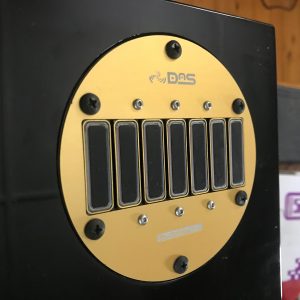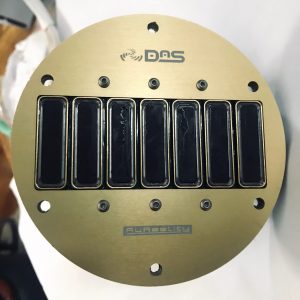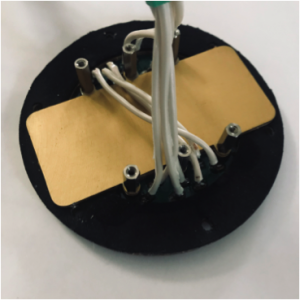BUILDING CONCERT HALL ACOUSTICS INTO EVERY FORM OF SPEAKER
The Experience
DaS is a truly unique sound technology that for all intents appears to by-pass the laws of physics as it redefines each space the speaker is placed into by removing the effect of time delays created by specular room reflections. Musically, this effectively recreates the exact soundscape imprinted into the recording by the producer when the recording was made.
Recreating the dimensional and textural space of the original sound or recording studio in which the recording or live performance was produced results in the REALITY that was intended, uncorrupted by interference overlays of specular reflections. It’s a quantum like effect that takes away the Newtonian influence of time and distance. It truly becomes SOUND BEYOND SPACE AND TIME.
DaS builds diffusion into the sound waves and transforms any space into the perfect listening auditorium! Rebuilding the architecture and aural soundscape of the recording studio into any listening space removes the need for complex room treatments and ensures no time delays reach the ear, ONLY THE PURE ENVELOPE.
The playback sound more accurately recreates the recording because you hear ONLY the recorded cues unchanged – it’s the same as being at the live performance. This HUMANISES sound because the psyco-acoustic cues are now the same as those produced in real time with no loss or corruption of spatial information – no matter where you stand in a room. The ‘reality cues’ are preserved unadulterated so the brain recognizes this as ‘real’ sound – and does not have to process the electro-mechanical derivations of normal speakers.
It doesn’t matter how much glass, concrete or wooden floors there are in the spatial environment, in fact DaS speakers sound better when they are challenged by difficult acoustic environments.
The experience is far richer and more authentic than the best of headphones or conventional speakers as our whole body experiences the soundfield as a living energy – the energy fills the room, with an extraordinary depth of field that provides a visceral emotional engagement. The ‘sweet spot’ is everywhere and the hearing impaired rediscover hearing anew with a heightened audibility, often without external aids.
The science
Conventional speakers have remained the same since Rice and Kellog invented the moving coil ‘cone’ loudspeaker or ‘piston radiator’ in 1921.
DaS AuReality, the audio technology invented by Joe Hayes is a fundamental shift in how loudspeakers operate and finally solves the inherent problems with moving coil speakers.
The piston radiator has one great flaw. Like a pebble dropped into a pond, the acoustic energy radiates out in perfect concentric rings. This means the listener can echo locate the loudspeaker through the reflection within the listening space. Reflections in the listening space fight against the clean perception of direct sound from the loudspeaker. Piston radiators also cannot reproduce reflections in the recording as though they where real reflections in real life.
Dr Toby Gifford, instrumental in the development of DaS technology, explains in more technical depth in the article: Near-field tangential particle velocities: piston radiator vs. QRD phased linear array
Or, his deeper mathematical explanation relating to car audio Near-field tangential particle velocities: piston radiator vs.QRD phased linear array:
‘Original recorded spatial cues do not get lost among listening-space specular reflections. More importantly, those cues are not distorted by the unavoidable product of conventional loudspeakers-swirling sound intensity off-axis”.
DaS technology emulates a point source: i.e. the sound-field radiates power uniformly in all directions … This effectively minimises soundfield distortion from the self-interference that is typical of traditional membrane drivers …
As a consequence, the spatial information encoded in stereo recording is maintained in pristine form by DaS, whereas traditional loudspeakers distort this information by confounding it with directionally confusing ‘eddies’ formed by self-interference … DaS also enhances signal-to-noise ratio by enabling physically larger drivers (with their greater capacity to excite a soundfield) to behave like small ‘point sources’.
Additionally, a DaS soundfield even has advantages over the (albeit theoretical) ‘ideal point source’. Both DaS and ‘point source’ radiate power uniformly in all directions, however a DaS soundfield is directionally phase auto-decorrelated … This is important because phase correlations give rise to phantom images when the soundfield is reflected from a hard flat surface (like a wall).Such phantom images are interpreted by the brain as reverberance and thus overlay spatial perception of the listening room on top of the spatial information encoded in the audio (as intended by the producer) … decorrelating the soundfield phase means that no coherent reflections are formed.
Thus with DaS, the spatial cues communicated to the listener are only those encoded in the recording-the direct sound, without the overlay of the particular spatial cues (typically undesirable) created by reflections caused by the geometry of the listening space.” the acoustic energy of DaS speakers travels outward in a radial pattern, whereas conventional loudpeakers create a number of ‘zones of confusion’ in which the energy flow (acoustic intensity) is not radial (i.e. toward the listener) but is tangential (think of it as a bit like the wake of a boat)-effectively robbing sounds’ pure spherical wavefront of the energy we listen for …This ‘energy conservation’ is very important. When all the acoustic energy is travelling radially from its source, there can be no energy travelling in a direction that might corrupt that sound-wave. This is not the case for conventional speakers, which will corrupt the sound-wave with their off-axis tangential energy (the main reason the ‘sweet spot ’of conventional speakers is so narrow) … Conventional speakers’ non-radial acoustic energy distribution corrupts the timing (and intensity) of such cues, leading our highly sensitive audiology to create a ‘false reality’ of the playback sound (something which we readily recognise as ‘not real’). Tangential energy locations might even appear as ‘phantom loudspeakers’, producing cues that have nothing to do with the audio signal! We’re of the opinion that this is why recordings mostly ‘sound like recordings’. DaS energy conservation, and much bigger sweet spot, means DaS speakers deliver even more accurate cues when configured as a stereo pair.
Add to that their autodecorrelation, which not only prevents specular reflections but reduces the ‘precedence effect’ (a psycho-acoustic effect that collapses the sound stage when one sits nearer to one speaker than the other in a stereo pair) and you may understand why DaS is so important to spatial sound-and particularly to multi-speaker surround sound.
DaS mathematical modelling shows exactly how DaS speakers work-and exactly why conventional speakers can’t match them … Add to that their autodecorrelation, which not only prevents specular reflections but reduces the ‘precedence effect’ (a psycho-acoustic effect that collapses the sound stage when one sits nearer to one speaker than the other in a stereo pair) and you may understand why DaS is so important to spatial sound-and particularly to multi-speaker surround sound.
Our mathematical analysis concludes that DaS is the most significant contribution to the playback of recorded sound since the invention of the Dynamic Loudspeaker. In fact, all the data-and listening tests-suggests that DaS speakers behave pretty much exactly as an ‘idealised point-source’. Whilst this has always been considered the ‘gold standard’ it has also been thought impossible-until now!
DaS ‘acoustic apodisation’ through ‘Diffusion At Source’ enhances the listener’s perception of intimacy, envelopment and clarity. Listening through DaS technology really does sound ‘like being there when the recording was made’.
Graphic explanation
DaS AuReality solves the problem of diffusion at the speaker source
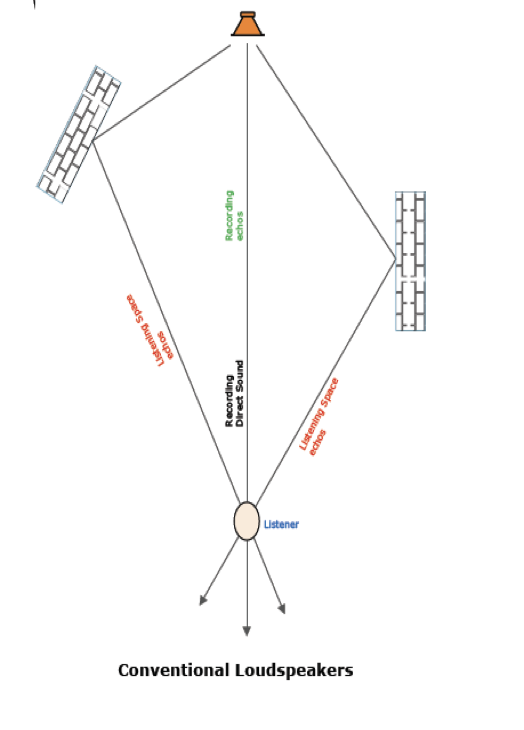
Conventional Loudspeakers in a Listening Room
Opposite shows the two main problem with conventional loudspeakers in a room.
Problem 1 – Recorded reflections in the audio are reproduced in the same way as the direct sound of the recording. Because of the perfect concentric rings (like the pebble dropped in the pond) the only direction for sound to travel is outwards. This means that both ears hear exactly the same sound. Stereo attempts to overcome this but is severely limited by what can be achieve with the difference between left and right audio.
Problem 2 – Hard surfaces in the room reflect an almost perfect copy of the sound form the loudspeaker, slightly delayed by the difference in the path length travelled, to the listeners head. These are in effect faint echos of exactly what the listeners hears directly form the loudspeaker. They are perceived as a degradation in sound quality. The combined effect of these two problems is to take the ‘reality’ out of the reproduced sound. It sounds like the musician are seated inside the loudspeaker. These problems ca be overcome through the exact science of designing an acoustic environment like a recording studio, or performance space, too, in part, manage these issues. But this is expensive and not always successful.
What DaS AuReality does that is different
As stated earlier, conventional loudspeakers play back the recorded echos in the same direction as the direct recorded sound. When a room reflects acoustic energy that energy tends to arrive at the listeners head form a lateral direction and not the same direction as the direct sound. So playing back recorded echos in the same direction as the recorded direct sound removes on of the biggest cues that a real sound would have – contralateral reflections (acoustic energy at right angles to the direct sound). If we look at the listening room echoes in the bottom diagram, and imagine this being a person listening to a real musical instrument in a room, the room echos come form the side. DaS AuReality does one fundamental thing. When an echo, caught by the recording process, is replayed it does so int the contralateral direction. Recorded echo play back at right angles to the recorded direct sound. The listener can now sit in the DaS AuReality sound field and feel like they are in a real listening environment like being in the room with the actual musician. This solves problem 1.
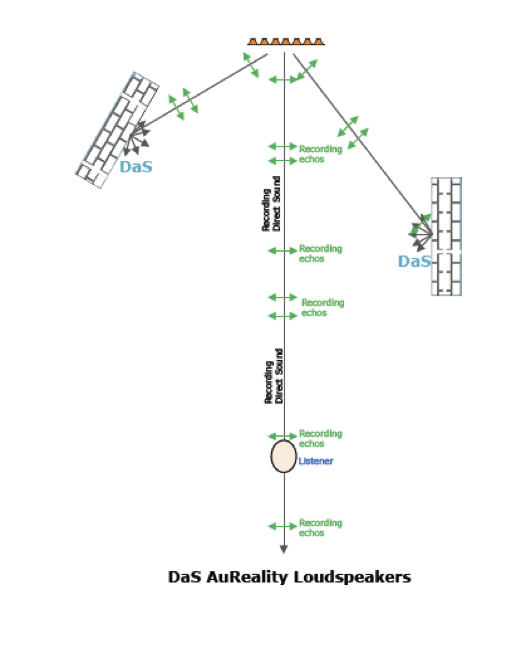
DaS AuReality over comes problem 2 as well. Part of the process used to create the contralateral recorded echos involves very fine sequence of time delays at the source of the sound. At the loudspeaker! We call this Diffusion at Source, and this is where the DaS acronym is derived. Das has little effect on the dirt sound to the listener. This is good as this is the main communication channel form the sound source to the listener. DaS does have a profound effect upon the reflections within the listening room. The fine time delays between adjacent bands of acoustic energy effectively diffuse the reflections form hard surfaces in the listening room. This renders the listening room to be free of specular reflections.
Conclusion
DaS AuReality is a novel loudspeaker technique that overcomes the legacy issues on conventional ‘cone’ loudspeakers. The benefits are a reproduction of a ‘real’ sound field that is just like listening to someone else in the room with you. If you are a music lover then its like the band is in the room with you. If you are hard of hearing then the elimination of specular reflections, a known curse for the hearing impaired, allows for significantly increased intelligibility by the user. The markets that can benefit form DaS AuReality include; gaming (augmented reality), public address acoustics, automotive (confirmed space acoustic control), consumer electronics (augmented reality), Hearing impaired devices, and communications through video conferencing, and handsfree modes on conventional telephony and smartphones.
Hearing Impaired
DaS speakers are particularly effective for the hearing impaired, who naturally struggle to deal with reflections, noise and reverberations. The speakers eliminate all of the interference, leaving a pure undistorted audio signal – the way the sound was originally intended to be experienced.
Consider this …
- Within the next 30 years one-in-every-ten people will have disabling hearing loss.
- The impact of hearing loss is estimated to be more than $100 BILLION annually in America alone.
Case Study – John Hirst spent $4,500 on a well-known brand of speakers and connected them to his TV. This did not solve the problem of John being unable to listen without turning the TV up to uncomfortably loud levels. The volume was so high, that his wife Pam was not able to tolerate it and couldn’t stay in the same room. After connecting a pair of the DaS speakers through his TV John found that he could listen to TV at normal levels.
Case Study – Jim Allen wears ‘receiver in the canal’ hearing aids and has a flat moderate sensorineural hearing loss in both ears. Normally to watch TV, Jim wears a hearing loop and has the captions turned on. After connecting the DaS speakers to his TV, Jim no longer needed to wear his hearing loop and could turn the captions off while still being able to follow the TV shows that he was watching. Jim found the output of the speakers to be clearer and more intelligible than the voices of those around him, even though they were seated right next to him, and speaking facing towards him.
Hearing impaired listeners can often dispense with assistive hearing devices plus the audibility of cellphone, radio, desktop and laptop speakers increases significantly.
Industry applications and benefits
DaS technology enhances every possible human listening experience –
Aesthetics of the musical experience
hifi, TV, cinema, car audio, radio, pro studio, concert hall, stadium, home studio, car audio
Heightened audibility/acute intelligibility for oral communication
lectures, talks, conferencing, phone, computer, car
Extra dimensional soundfield
hifi, tv, cinema, gaming, studio, VR
The benefits are highlighted in the complete performance, production and listening experience
DaS takes the pain out of venue acoustics allowing a clean mix with ease, no matter how poor the venue architecture PLUS reverberation textures can be introduced into the performance and you hear exactly what you want.
Announcements in large public spaces such as airports, railway and bus stations now can achieve a level of intelligibility not possible before – even in the most challenging acoustic environments.
Pro and Home Studios, whether recording performances, interviews, podcasts, radio programs or movies, the pain of costly room treatments is removed. A standardized reference sound also allows the sharing of mixes with reliability. Easily deconstruct the work of mentor producers.
For HiFi, cinema, home theater, gaming and VR, the extraordinarily specific positioning of every sound gives an extra dimensional spatial depth. The “psycho-acoustically accurate” perception of pure spatial imagery allows a truly realistic sound – the humanization of cues normally lost with conventional ‘non-DaS’ stereo speakers. The ‘spice’ is truly added to the listening experience.
Building Concert Hall Acoustics into every form of speaker
The great acoustic challenge for Car Audio, the extremes of confined spaces, means its virtually impossible to create a predictable sound field so the driver/passenger experience in highly compromised…..until now. DaS allows the elimination of standing waves
Smartphones gain a massively enhanced intelligibility and musical aesthetic as u-sound drivers open up DaS design options.
Computers, desktops, laptops, tablets, Ipads achieve a pronounced intelligibility for voice interaction and web conferencing without fatigue or straining to hear the voice you want in the throng.
In the world of the hearing impaired, the audiological benefits of DaS allows a whole new audible lifestyle for many, hearing TV, radio and Hifi without aids and the potential for audible smart homes.
Technology hardware variants
DaS technology can be introduced through 3 methods. The most generally applicable is the array approach:
Array – the digital ‘maxi’ way. Using multiple drivers and digital delay techniques to create ‘Diffusion At Source’. This method is particularly suited to high-power applications such as concert PA.
Reflector – the specialist analog ‘micro’ way. Using a modified Quadratic Residue filter, the sound is bounced off it to create ‘Diffusion At Source’. This produces a clearly audible (and measurable) effect in the frequency band that contributes to our spatial awareness. This approach is readily compatible with conventional speaker-driver design, construction and components.
Manifold – the ‘middle’ passive way. Using a multi-port design to create ‘Diffusion At Source’ from a single driver, this low-cost method is particularly suited to applications in consumer audio, TV, Smartphone, in-car audio and, information PA and ceiling speakers.
The DaS Array in production for specialist prototyping applications
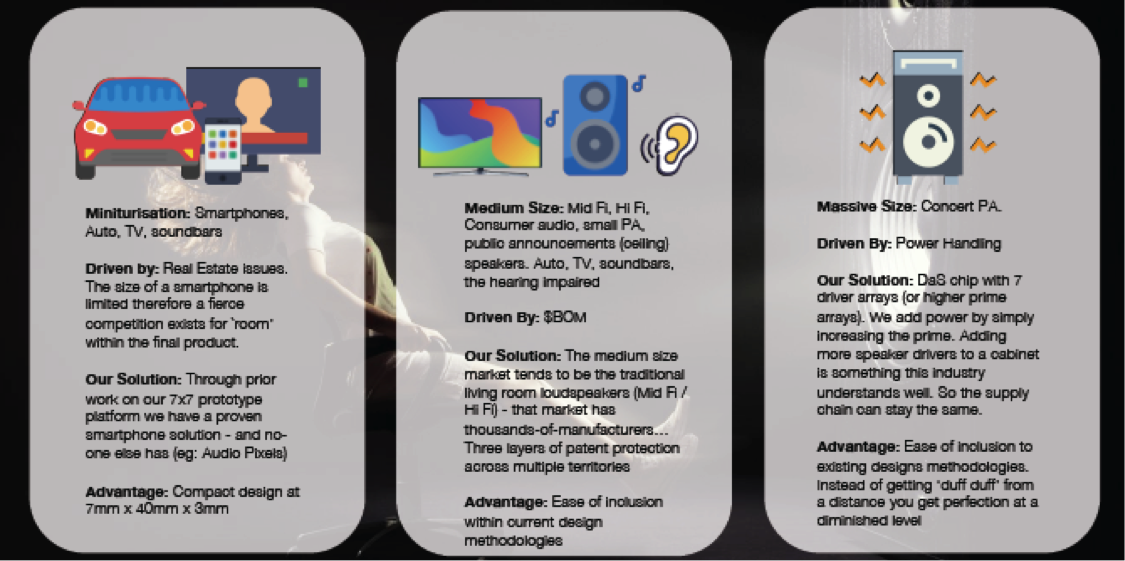
SOUNDBAR – Case study
In this case study, we lay out the requirements for a soundbar product realisation incorporating DaS Tweeter technology.
The DaS Tweeter selected consists of a 7 driver array. DaS Technology requires multiple channels of amplification. In the case of a 7 driver array, it requires 4 channels of amplification.
Texas Instruments has released a series of inductor-less amplifier chipsets. The Texas Instruments TAS5825M (with built-in DSP) has an output power up to 2x50W (4Ω), or it can be used in bridge mode for 1x100W (4Ω). It includes automatic thermal foldback and recovery for sustained power. They run on a 5VDC to 24VDC power supply.
The TAS5825M has the ability to store the DaS algorithms within its DSP settings.
Each DaS Tweeter uses 2 x TAS5825M to achieve the requisite 4 channels of amplification. Each channel is capable of delivering 50W(4Ω). That gives 200W for the DaS Tweeter. The Das Tweeter drivers are 3W(4Ω) each. The array power is 7 x 3W(4Ω) = 21W. A rule of thing is to use twice the amplification power as the speaker driver. Thus minimal amplification power is 2 x 21W – 42 W. With 200W available it would be possible to select other amplification chips that achieve around 10 to 15 watts per Das Tweeter Chanel. But so the sake of simplicity we will stick to the TAS5825M in this build.
Each woofer is powered by 1 xTAS5825M giving 100W(4Ω).
Each stereo side of the sounder, therefore, requires 3 x TAS5825M. The complete soundbar requires 6 x TAS5825M.
In this design, we use a small `off the shelf’ amplification assembly that contains 2 xTAS5825M. If used as a master it has an onboard Bluetooth and outputs an I2S signal. If used as a slave it deactivates its Bluetooth and inputs an I2S signal. The I2S output from the master is fed to the other two slave amplifier sub-assemblies. Each amplifier is programmed to respond to either left, right, or mono from the I2S signal.
The soundbar will be powered by an external power adaptor (Mean Well GST160A24-R7B @ 160 watts 24VDC). Alternatively, it could use an onboard switch mode power supply (such as the Mean Well LRD-150-24 @ 160 watts 24VDC). We have selected the external power adaptor to simplify regulatory issues.
The simplified Bill of Materials (BOM) becomes;
- 2 x DaS Tweeters
- 2 x Woofers
- 3 x COTS programable Amplifier modules
- 1 x Soundbar Enclosure
- 1 x sundry connectors and hardware
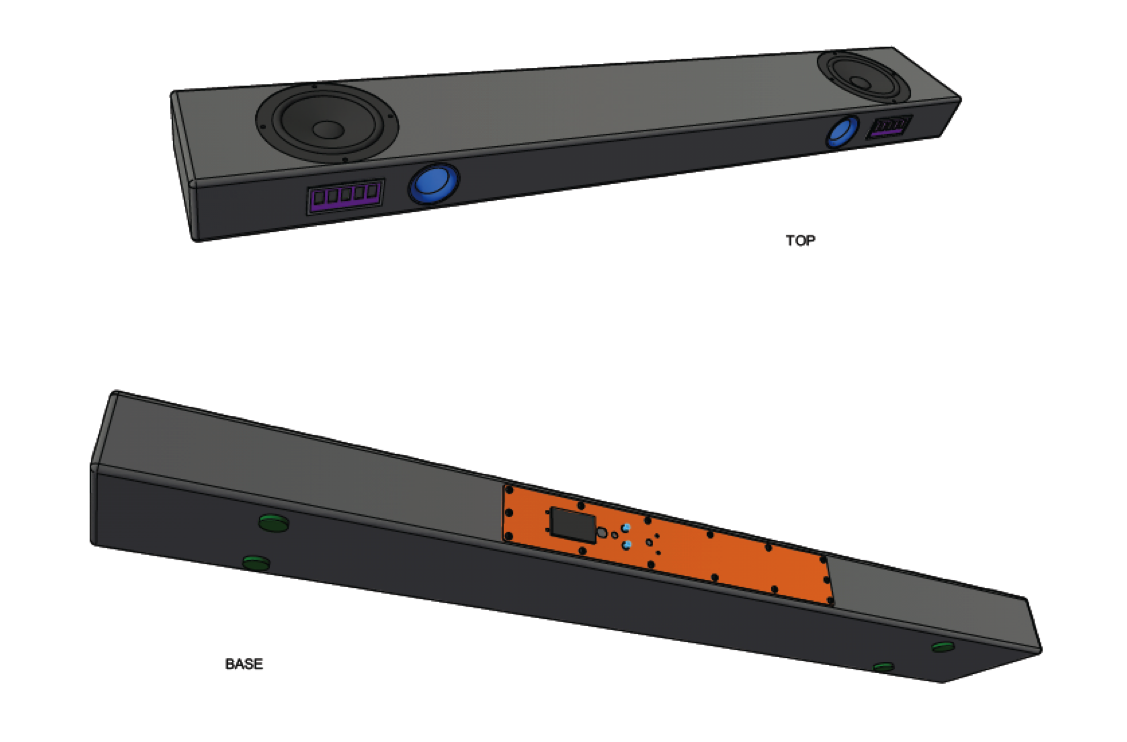
For more information on how DaS can benefit your speaker technology
Browse the pages of this website or request a detailed information pack to be sent to you or contact us directly at Vastigo, the global licensing agent for
DaS AuReality via the Connect page.

